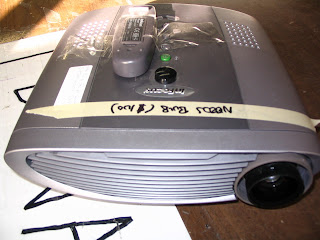I like old video projectors. They've been around in some form since the dawn of television -- the old CRT-based ones were technically the same as televisions with the brightness cranked so that they'd throw an image onto a screen. These evolved into huge three-tube monstrosities that you can now get for the price of a hernia.
But when the LCD display came along things got more interesting. In the late 80s someone started manufacturing little units that sat on top of a classroom-standard overhead projector. IBM's Thinkpad 755CDV laptop from 1995 could have the back of its display stripped off so that it could be similarly used to project an image.
By the end of the 1990s digital projectors had taken a familiar shape and dropped massively in both weight and price... but in the meantime there were some weird species in circulation. I already wrote about one (see the end of the article). Here's another. Excluse the blurry photography.
It's a Proxima Desktop Projector 2400, original MSRP $6295 in 1997 or so. But it's not at all apparent what's what on first glance.
On the back of the unit, we aren't even graced with a VGA input -- just s-video and composite. It looks like those two inputs are on a removable plate, so I suspect that there's an interchangeable circuit board converting various kinds of inputs into something the projector understands -- VGA was probably another option. Or perhaps the big DB-25 connector to the left of those, labeled "computer", was a custom cable for another kind of input? It's not at all clear. (Proxima isn't overly worried about creating non-standard cables for no good reason, given that they've included a non-standard RS-232 connector above that.)
Note the "Lamp Select" switch; we'll come back to that in a sec.
So we've seen the back and the front and something important is missing: uh, the lens. Back around to the front of the beast:
If we flip up the plastic slab labeled "Proxima"...
...then lift the crenellated plastic on the front...
Hey presto, it's a projector! Kind of like the Transformers version of one. (Please, no Optoma Prime jokes.)
Back to that Lamp Select toggle on the back:
This is a definite inheritance from the good old overhead projector. When a lamp would fail, you could throw the switch to flip in a spare. This saved the presenter from having to crack open the machine, track down a spare bulb, burn their hands on the dead one, etc. Let's have a look at the inside of the machine:
You can see two silver bulbs opposing each other, with a chunk of something black in the middle.
Flip the "Bulb Select" toggle, and two things happen:
First, a mirror slaps into place facing the bulb you've selected. Second, an electrical switch supplies power to that bulb. Neat.
These bulbs ("FXL" halogen bulbs) are dirt cheap -- $6 a pop. Again, the use of FXL is an inheritance from traditional overhead projectors. This, unfortunately, has changed -- heading into the 2000s projectors started using bulbs that cost hundreds of dollars, inviting comparisons with inkjet cartridge racketeering. These prices are hard to justify, especially when you can get a brand new projector, bulb included, for under $250. That's why stuff like this ends up in the recycling bin:
If you ask me, as with ink cartridges and gasoline prices on a long weekend, there is actually something illegal going on here. It's profit-motivated planned obsolescence. And the end result is that a lot of perfectly usable equipment gets scrapped because the manufacturer would rather sell you a new one.
Back to the Proxima projector, born before the FXL bulb was deep-sixed for being Insufficiently Profitable. Sadly, I scrapped this one too. Its 640x480 resolution wasn't going to win any awards and without a VGA input it wasn't terribly useful. Old LCDs often have poor contrast levels and slow response times. I would've been content to send it down to the store so they could blow it out for $10 to some happy experimenter but it wouldn't fully power up. That's three strikes. But it was still neat to see a projector with such a visible design heritage.









No comments:
Post a Comment
Note: Only a member of this blog may post a comment.